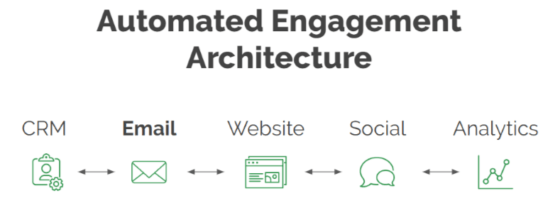…And get back weeks of your life in the process
Are you the sort of communications professional who deals with limited resources while juggling multiple responsibilities and roles? Right, silly question. I’ll cut to the chase – you need engaged audiences if you want effective communication that delivers on your strategic goals.
Automation may sound like wishful thinking (or the start of a robot uprising), but it’s real, it’s readily available to you right now, and it can have an incredible impact on…well, on your impact. Nothing beats resource limitations quite like a low-cost robot handling some of those responsibilities for you!

Automating your entire Engagement Stack (that’s everything from your CRM, Email Marketing System, website, etc.) can be a large investment of time and money. However, starting your automation journey with a Welcome Series of emails is one of the most important steps you take in engaging with your audiences.
That doesn’t mean you can toss something together on a lark and watch your engagement metrics bust through the roof. An unplanned campaign might do worse than just miss the mark – it may be unmeasurable, the lessons learned might be impossible to identify, and you can even run the risk of giving your new subscribers the wrong idea about what they can expect from your organization.
But not to worry…in this article, I’ll walk you through everything you need to do to create a robust Welcome Email Series that streamlines rapport building with cold leads and scales into your future automation efforts.
![]()
Why an Automated Welcome Series?
With over 74% of new subscribers expecting a welcome email as soon as they join a mailing list*, you can’t leave them waiting. And since your welcome emails are likely to get 4x the open rates of your typical emails* – and 5x the click through rate (!) – is this really the sort of thing you’re willing to put off for later? 1
Wait, really?
Think about it – if someone comes to your office for the first time, are you going to leave them hanging around at the front desk for hours before saying hello? Of course not.

And, when you do welcome them in, are you just going to say, “make yourself at home” and walk away? I hope not! I’m pretty sure you’ve got a few highlights that you have to make sure to point out (i.e. where to get coffee, how to find the restrooms, the printer that never works…).
Wouldn’t it be great if – despite being as busy as you are – you had time to offer a personal walkthrough of your organizational highlights for every subscriber who expressed interest on your website?
That’s exactly the sort of job you can delegate to your Automated Welcome Series.
![]()
How Much Time Do You Need To Spend Planning?
To be successful with a Welcome Email Series – there’s some careful – but brief! – planning that needs to happen first.
And don’t worry, I get it. You’ve got way too much going on already. How are you going to find time to decide on what to write? You’re probably thinking of clicking away to Google to find a simple copy-and-paste sort of template. There are plenty of those available if you look, but…
Without taking the time to plan your messaging, you’re going to let a generic, carbon copy welcome message speak for your organization. Is that the first thing you want to communicate to someone who’s brand new to your organization and asked to learn more?
If you haven’t thought about your strategic goals for new subscribers, you’re not making choices that further those goals. You won’t have a way to determine if your welcome series is working or not. Without specific goals for the knowledge you want to impart and the actions you want new subscribers to take, what does success even mean?
So what happens if you do take the time to plan?
When ParsonsTKO has helped organizations plan strategic changes and the crafting of totally new automations, these clients have seen across-the-board boosts in their engagement metrics, such as:
- Higher-than-average open and click-through rates
- Higher event registration
- Increased member retention and donation rates
- Earlier membership renewals (with many members renewing months before expiration)
Sound like something you’d be interested in? We’ll lay out the exact steps to follow to do the same for your organization’s key engagement metrics.
How Do You BUILD An Engagement Strategy?
There are 3 big questions to research before drafting emails. In fact, once you’ve answered these questions, your welcome series will practically write itself (how’s that for automated?).
- What actions should your audiences take?
- What content will motivate those actions?
- What’s the best way to introduce the content?
What actions should audiences take?
That’s a bit of a loaded question. Here are a few additional questions to help answer the larger one:
- First off, who is the audience for this welcome series?
- What is the ‘most valuable action’ this audience can do for your organization?
- Ex. donate, volunteer, host a meeting, join a panel, etc.
This last question might be the most crucial in terms of identifying these audience actions. ParsonsTKO has found that organizations struggle with this initially if they haven’t thought about it before. That said, it’s worth it to take the time to answer this next question fully:
- What are the steps an audience member typically goes through before they do that ‘most valuable’ thing?
- Ex. they might need to attend several events before being likely to donate, and before they attend an event they might need to register for a webinar.
Now you have a clear sense of who you’re writing for, and the journey you can write about. A brief email to a new subscriber about needing donations is very different than an email explaining how your introductory webinar works and how excited your volunteers are to attend your annual charity gala.
What content will motivate those actions?
Ultimately, our goal here is to create a clear picture of what you want new subscribers to do, and then connect that to content, which already exists, that can amplify your message.
So, what do you want to say and what do you want people to do when they first learn about your organization?
Consider:
- What are this audience’s primary challenges and questions?
- What does an audience member need to read / hear / see before they take the each step in their engagement journey?
You intuitively do this when you talk to someone in person, so the trick is to make sure your emails do it too.
An important note here is to prioritize content that can be repurposed, rather than needing to be written from scratch. This will give you the most ‘bang for your buck’ when it comes to automation. If a piece of content is already popular, you’re better off sharing it with new subscribers than trying to find the time to draft untested content.
What’s the best way to introduce your content?
 Think back to our office tour example above. You’re not just going to throw a huge stack of papers in someone’s lap as soon as you’ve shaken their hand. There’s a story you want to tell, a process you want to unfold, and some framing you want to give to each of the content pieces you’ll share with them.
Think back to our office tour example above. You’re not just going to throw a huge stack of papers in someone’s lap as soon as you’ve shaken their hand. There’s a story you want to tell, a process you want to unfold, and some framing you want to give to each of the content pieces you’ll share with them.
Most likely, you and others in your organization are already doing this as you interact with people in presentations and public events. Let’s look ahead to our email arc to plan how best to transform your current messaging into an automated email series.
Planning Your Arc
For a three-email welcome series you’ll be introducing your organization, highlighting its value, and inviting readers to engage. While the best emails rely on strategies with addictive storytelling features, like open loops, cliffhangers, and the hero’s journey…you don’t need those to have an effective Welcome Series. Remember, most organizations don’t even bother to say hello when someone subscribes to your list…and those that do, don’t follow up with a full welcome series.
Below you will find some framing suggestions for the first 3 emails in your welcome series. Your welcome series can be as long as you like, but I recommend you get started with something a bit more simple so you can see how it performs with your audience(s) and adjust from there.
Email 1 – The Introduction
Goal: Introduce your organization
Send: As soon as the subscriber joins your list
In this email, you will:
- Remind the reader what they’ll be seeing now that they’ve joined your list
- Help them paint a picture of themselves as an engaged participant in your org
- How do people tend to get involved? Share it. Keep it simple for this email, just a sentence or two.
- Promote a piece of content that your constituents have found invaluable – maybe one of your most popular blog posts. It should be one that doesn’t require a lot of institutional knowledge to be valuable. Just imagine what you’d like to see after you hear a really exciting elevator pitch about the work someone is doing.
- Ask for something specific / offer a call-to-action . This could be simply ‘read this content’ or ‘let us know what kind of content you want to see more of’.
- The easier for the subscriber to complete the better, here. If you can offer 3 choices – A, B, or C – and ask someone to respond with just a single letter to let you know what they think, you’ve already built the habit of engaging with your messages!
- Ex. Most of our subscribers are looking for one of the following, which are you most excited for?
A. Upcoming event details
B. Opportunities to volunteer
C. Trending news related to our mission
You can respond to this email with just the letter of your selection if you don’t have much time. We’d love to hear from you!
Email 2 – The Story
Goal: Tell the story of your organization and describe one of your unique strengths (your org’s superpower!)
Send: 2 days after the subscriber joins your list
In this email, you will:
- Remind the reader what they learned in the last email (in case they missed it – which you can assume they did, since attention spans are so short nowadays).
- Keep painting that picture of themselves as an engaged participant in your org
- This is a great time to weave in a personal story from others who have joined your list / engaged with your organization. If the protagonist relates to them in some way, they’re going to form a very quick connection with your organization because they can picture how they fit into it!
- Promote a piece of content that focuses on a specific strength of your organization
- If you have 2 or 3 unique strengths / member stories, those can simply be additional messages in your welcome series!
- Ask for something specific / offer a call-to-action
- Look to the challenges/questions you brainstormed earlier and suggest something that will address that here.
Email 3 – The Invitation
Goal: Invite the subscriber to support your organization
Send: 4 days after the subscriber joins your list
In this email, you will:
- Remind the reader what they learned in the last emails (in case, once again, they missed them).
- Keep painting that picture of them as an engaged participant in your org
- Think of someone who has done that ‘most valuable action’ with your organization. How did it change them? Could they offer a testimonial?
- Promote a piece of content that focuses on fleshing out that ‘most valuable action’
- Consider a brochure, case study, blog post from an engaged member/donor, etc.
- Ask for something specific / offer a call-to-action
- Invite them to take the next step(s) in joining your organization!
Next Steps
At this point you’ve already done some incredible work. You’ve taken a deep look at your current subscribers and members to identify what they want and when they want it. You probably have some really good theories – based on feedback and insights from staff – about what motivates your audiences to take the next step on their respective engagement journey.
Remember, your goal with automation is to shepherd your audience along in their journey to deeper understanding and commitment to your organization. With every step, an audience member deepens their relationship with your organization. Your efforts to look at that journey holistically are commendable…but now it’s time to put those theories to the test.
Your next steps are:
- Draft the 3 emails detailed above.
- Import them into your Email Marketing System of choice (Ask us for a recommendation, if you’re just getting started and don’t already have a system ready to go).
- Set up the automations as suggested above: email 1 on list sign up, email 2 two days later, email 3 two days after that
- Test the automation, and then…
- Drop the opt-in form on your website (and test that as well)!
After that, you’ll want to take a look at the overall performance of these emails. That includes everything from when and where people are most likely to opt-in, when and who opens the emails, when and who clicks once they open, etc.
Once the Welcome Series automation is launched, you will no doubt want to create more advanced automations. Our recommended next step for many organizations, is to look at what happens with subscribers who never interact with your emails vs. those who do (AKA- lead scoring).
If you need help with any step of this process – from strategy and planning, email creation, automation building, and even campaign performance analysis – ParsonsTKO is ready to help continue building these automations.







